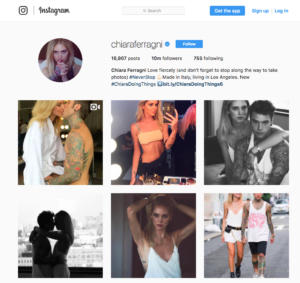Let engagement drive your influencer marketing strategy
 By Matthew Steele
By Matthew Steele
8 of the 10 most recognizable "celebrities" for teenagers are YouTube stars. Even if most of these so-called stars are unrecognizable to you, your audience may be hanging on every word they say. Even though high profile influencers may have enormous reach there are lower tiers of influencers that can still effectively spread a message. Learning about the three tiers of influencers - mega, macro and micro - can help you find the right influencer for your campaign or brand.
Mega-influencers
Mega-influencers are flat out famous. They could be actors, musicians, reality celebrities, social media icons or anyone with over 1 million followers. Although these folks have extensive reach, their engagement rates only scuffle around 2-5%. Frankly, it's impossible to create an individual piece of content that strikes a chord with that many people. Mega-influencers are best suited for generating overall awareness for your brand, quickly. Engagement rates might not be high, but a blast of your content to over a million people will certainly make your brand more recognizable. These are real celebrities, though, so successfully reaching them without a mutual connection would probably require some divine intervention. What's more, these influencers generally only associate with national brands or high-end products. Only a small subset of brands will have access to the coveted Hollywood elite without an introduction or a lot of money.
Macro-influencers
Macro-influencers, with typically between roughly 10,000 - 1 million followers , have higher engagement rates at 5-25%. They also have an audience that can be generally grouped around a particular interest making them particularly powerful as influencers. While someone could follow Kim Kardashian for a myriad of reasons, another might only follow Chef Andrew Zimmern if they're interested in a combination of food and travel, for example. Despite living lives of relative celebrity, they macro-influences don't have that same superstar vibe. That makes them not only easier to reach but more likely to take a conversational and organic tone in their sponsored content. One note here is that although many YouTube stars have over 1 million subscribers, I would lump them in with this category. That's mainly because as influencers sponsored content is often their main source of income. That makes them more receptive to inbound requests.
Although macro-influencers can't generate brand awareness as fast as mega-influencers can, because of their engagement rates they are often more adept at delivering conversions and sales.
Getting influencers of any size to help promote your brand can yield huge benefits. But unless you pick the type of influencer that's right for your brand, you could waste a lot of time and effort.
Micro-influencers
Micro-influencers are the niche players in the influencer marketing game. These industry-specific experts usually have followings anywhere between 500-10,000. Their fans are even more engaged than macro-influencers, with engagement rates soaring above 25% in many cases. You can learn a lot about a micro-influencer just from their Twitter profile, in which they've probably linked to their website, discussed their interests and possibly even provided contact info. Despite a relatively low profile in terms of reach, micro-influencers can be tough to partner with as they vet sponsors very carefully. Their reputation as a thought leader in a particular space depends on their credibility. Endorsing a low quality product could erase years of work spent establishing reputability. These influencers have a specific field of expertise, so don't approach them with a product that's only slightly related to their interests.
The strength of micro-influencers is they'll lead you directly to a exactly the audience you want to reach. Seek out micro-influencers primarily to spur conversions and tap into your target market. Don't carpet bomb a bunch of them in the hopes of hooking one. Build relationships with them one by one, over time before you. You can l earn more about micro-influencers in our complete guide here.
Mega- here, Macro- there
Some influencers can be "mega" on one channel, and "macro" on another and it's important to note this difference. Italian model Chiara Ferragni has recently been posting some sponsored content on her Instagram feed, where she has over 10 million followers. Her Twitter account, with a relatively sparse 350k followers, is devoid of sponsored content. It makes sense that the account of a supermodel would be more popular follow on Instagram than Twitter, and Depop (an international clothing retail outlet) was smart to recognize that. Pay attention to where your influencers carry the most sway to help identify where they might be mega-, macro- or micro- and plan accordingly.
Be aware that engagement rates also vary dramatically depending on what platform an influencer uses. Instagram tends to generate much higher engagement than Twitter, despite Twitter's capacity to effortlessly retweet a post. Within the past week, the New England Patriots posted identical content to both their Instagram and Twitter feeds. Although the Patriots' Twitter following exceeds their Instagram following by 800k, the posts were roughly 15x more popular in terms of likes/retweets when posted on Instagram. The projected engagement rates listed above are probably not completely accurate across channels, but give you a good sense of what you should expect between tiers of influencers.
Communicating with influencers of any level of clout can be difficult. As with any human interaction, some people are easier to work with than others. It's a crucial bond to forge nevertheless. A poorly conceived campaign damages the influencer's stature and jeopardizes their status as an influencer going forward. Businesses should be very upfront with their expectations from influencers, and work collaboratively to develop content that satisfies the brand's aspirations as well as the influencer's stylistic predispositions.
Reaching influencers requires a carefully crafted message that demonstrates how a partnership benefits both sides. Be adaptable to them and their style of content, and they will return the favor. Influencer marketing is here to stay, so develop your brand's strategy for reaching influencers before you get left behind.
